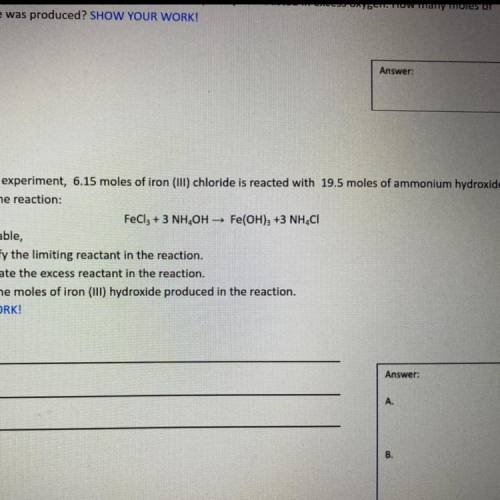
Chemistry, 05.03.2021 22:50 haleymoodie6034
In a chemistry experiment, 6.15 moles of iron (III) chloride is reacted with 19.5 moles of ammonium hydroxide
according to the reaction:
FeCl3 + 3 NH, OH → Fe(OH)3 +3 NH, CI
Using a RICE table,
a) Identify the limiting reactant in the reaction.
b) Calculate the excess reactant in the reaction.
c) Find the moles of iron (III) hydroxide produced in the reaction.
SHOW ALL WORK!
R.
1
A.
С
E
B.


Answers: 1
Another question on Chemistry

Chemistry, 22.06.2019 12:00
1. if you have a gas at 127 degrees c, what is it's absolute temperature (kelvin)? a. 200kb. 300kc. 400kd. 500k2. if you had a gas whose absolute temperature measured 45 k, what is that temperature in celsius? a. -228 cb. -300 cc. 125 cd. 112 c
Answers: 2

Chemistry, 22.06.2019 12:00
Marcel just purchased 1.69 grams of iron fillings in order to make living putty for his 6 year old niece. how many moles of iron are made in his sample?
Answers: 1

Chemistry, 22.06.2019 12:30
How many grams of magnesium metal will react completely with 8.3 liters of 5.5m hcl? show all work
Answers: 1

You know the right answer?
In a chemistry experiment, 6.15 moles of iron (III) chloride is reacted with 19.5 moles of ammonium...
Questions








English, 06.07.2019 03:30

History, 06.07.2019 03:30

Biology, 06.07.2019 03:30

Mathematics, 06.07.2019 03:30

Mathematics, 06.07.2019 03:30








Mathematics, 06.07.2019 03:30



